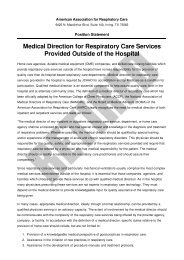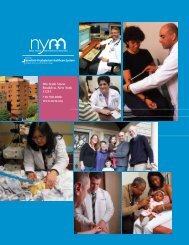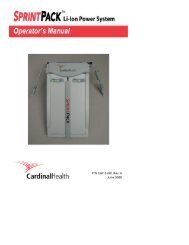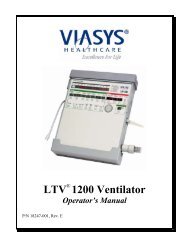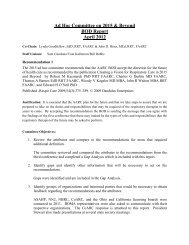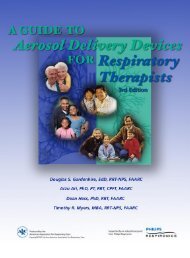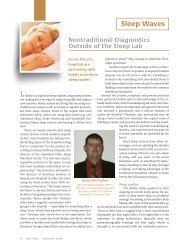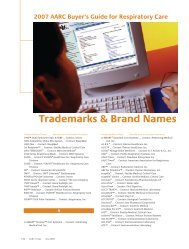RPSGT Examination Matrix - AARC.org
RPSGT Examination Matrix - AARC.org
RPSGT Examination Matrix - AARC.org
Create successful ePaper yourself
Turn your PDF publications into a flip-book with our unique Google optimized e-Paper software.
qTake corrective action by making appropriate repairs or changes in recording parameters toassure the recording is adequate, including but not limited to the following:• Use back-up or alternative derivations• Alter montage to maintain essential information• Wake patient to replace/reposition electrodes or other monitoring devices• Alter patient’s environment (e.g., turn on/off air conditioning)• Change amplifier settings• Replace faculty equipmentKNOWLEDGE/SKILLS/ABILITIES STATEMENTS:15 Problem-solving skills16 Clinical reasoning18 Polysomnographic equipment and related peripherals, their uses and limitations23 Equipment-specific operating and calibration procedures26 International 10-20 electrode placement system27 Appropriate electrode/sensor application/removal techniques29 Expected waveforms for each parameter (e.g., EKG, EOG, EMG, EEG, etc.)30 Potential artifacts, their sources and appropriate corrective actionsTASK 3.04 Implement appropriate interventions (including therapeutic interventionsuch as continuous and bi-level positive airway pressure, supplemental oxygen, etc.and actions necessary to assure patient safety and well-being).The technologist will recognize the need for and be able to implement interventions includingbut not limited to:qqqqqqqqqqqqqqqqqqqResponding appropriately to patient's medical problems (e.g., seizure, diabetic, strokepatients)Assuring the availability and proper function of emergency equipment and supplies (e.g.,crash cart, suction, and CPR board)Ensuring that patient safety is not compromised due to electrical of mechanical hazardsRecognizing “normal” versus abnormal cardiac rates and rhythms for patients based on theirindividual medical historyInitiating CPR for adult, child or infant when appropriateImplementing appropriate precautions and/or procedures for other medical conditionsIdentifying indications, contraindications and/or side effects of PAPObtaining and verifying physician’s order and implement special procedures, whenindicated, for PAP therapyUsing appropriate devices for PAP titration and supplemental oxygen administrationSelecting and fitting appropriate PAP patient interface devicesTitrating and documenting PAP level (s) to achieve therapeutic goalVerifying optimal PAP relative to sleep state and sleeping postureObtaining a physician order for, and interface the delivery of, supplemental O 2 whenindicatedAdministering nocturnal supplemental O 2 per physician orders and protocolsVerifying physician orders according to patient’s current medical historyRecognizing indications, complications and contraindications of O 2 therapySelecting and evaluating appropriate oxygen delivery equipmentApplying appropriate O 2 delivery device, ensuring proper fit and patient comfortTitrating and documenting O 2 level (s) to achieve therapeutic goal25
KNOWLEDGE/SKILLS/ABILITIES STATEMENTS:05 Pathophysiology (especially as it related to or impacts sleep studies; e.g., breathingdisorders, cataplexy, parasomnia activity, seizures, cardiac dysrhythmias, etc.)06 Medication effects (especially as they relate to or impact sleep studies and patients'needs)07 Polysomnographic procedural protocols (including overnight sleep studies, MSLT,MWT, PAP, etc.)14 Communication skills16 Clinical reasoning21 Therapeutic modalities/techniques23 Equipment-specific operating and calibration procedures25 Infection control procedures (e.g., sterilization, airborne diseases, etc.)32 Emergency response procedures (e.g., CPR, fire, etc.)33 Appropriate procedures related to patient safety (e.g., seizure sleep walking, etc.)34 Event characteristics (e.g., respiratory, cardiac, sleep stage, etc.) and professionallyaccepted scoring guidelinesTASK 3.05 Document routine observations, changes in procedure, and significantevents to facilitate scoring and interpretation of polysomnographic results.The technologist recognizes and documents events including but not limited to the following:qqqqqqqqqqqqqqqqqqqqqClock time at regular intervalsBody position changesChanges made during recordingPatient complaintsEnvironmental conditions (e.g. noises, light)Interventions or treatments (e.g. adjusting electrodes, applying PAP etc)Verification of readouts from ancillary equipmentEquipment problems or malfunctions and steps taken to correct themElectrode integrity checks at regular intervals (e.g. electrical interference checks andimpedance checks)Respiration and heart rate at regular intervalsSeizure activityApnea/hypopnea/respiratory event-related arousalsOxygen desaturationsCarbon-dioxide retentionAbnormal cardiac rhythmsUnusual vocalizations/motor activityViolent behaviorsCataplexy or sleep paralysisUnusual EEG findingsDifficulties falling and/or remaining asleepPatient discomfortKNOWLEDGE/SKILLS/ABILITIES STATEMENTS:04 Sleep disorders (signs and symptoms)05 Pathophysiology (especially as it related to or impacts sleep studies; e.g., breathingdisorders, cataplexy, parasomnia activity, seizures, cardiac dysrhythmias, etc.)06 Polysomnographic procedural protocols (including overnight sleep studies, MSLT,MWT, PAP, etc.)09 Observation skills18 Polysomnographic equipment and related peripherals, their uses and limitations29 Expected waveforms for each parameter (e.g., EKG, EOG, EMG, EEG, etc.)30 Potential artifacts, their sources and appropriate corrective actions26
32 Emergency response procedures (e.g., CPR, fire, etc.)33 Appropriate procedures related to patient safety (e.g., seizures, sleep walking, etc.)34 Event characteristics (e.g., respiratory, cardiac, sleep stage, etc.) and professionallyaccepted scoring guidelinesTASK 3.06 Follow "lights on" procedures to verify integrity of collected data andcomplete the data collection process.The technologist performs and documents events including but not limited to the following:qqqqqAwaken patient and record time of "lights on"Perform post-test calibration procedureRemove electrodes and other recording devices using appropriate techniqueGently and effectively clean all electrodes/adhesive contact pointsAdminister post-sleep questionnaireKNOWLEDGE/SKILLS/ABILITIES STATEMENTS:07 Polysomnographic procedural protocols (including overnight sleep studies, MSLT,MWT, PAP, etc.)14 Communication skills23 Equipment-specific operating and calibration procedures24 Electrical safety25 Infection control procedures (e.g., sterilization, airborne diseases, etc.)27 Proper electrode/sensor application/removal techniques31 Physiologic calibration procedures for each parameter (e.g., EKG, EOG, EMG,EEG, etc.)DOMAIN 4. PERFORM POLYSOMNOGRAPHIC RECORD SCORINGTASK 4.01 Score sleep/wake stages by applying professionally accepted guidelines.The technologist will identify EEG patterns associated with sleep, and score the stages of sleep,following scoring guidelines in Rechtschaffen and Kales Sleep Stage Scoring Manual.KNOWLEDGE/SKILLS/ABILITIES STATEMENTS:01 Medical records (e.g., sleep study orders, consent forms, medical charts, etc.)02 Basic physiology03 Sleep disorders (signs and symptoms)04 Pathophysiology (especially as it related to or impacts sleep studies; e.g., breathingdisorders, cataplexy, parasomnia activity, seizures, cardiac dysrhythmias, etc.)05 Sleep disorders nosology06 Medication effects (especially as they relate to or impact sleep studies and patients'needs)07 Polysomnographic procedural protocols (including overnight sleep studies, MSLT,MWT, PAP, etc.)16 Clinical reasoning18 Polysomnographic equipment and related peripherals, their uses and limitations21 Therapeutic modalities/techniques22 Basic bi-potential electrophysiology (e.g., EEG, EMG, ECG)23 Equipment-specific operating and calibration procedures26 International 10-20 electrode placement system29 Expected waveforms for each parameter (e.g., EKG, EOG, EMG, EEG, etc.)30 Potential artifacts, their sources and appropriate corrective actions34 Event characteristics (e.g., respiratory, cardiac, sleep stage, etc.) and professionallyaccepted scoring guidelines27
TASK 4.02 Score clinical events (such as respiratory events, cardiac events, limbmovements, arousals, etc.) according to current professionally-accepted guidelines.Events scored include but are not limited to:qqqqqqqqqBody movementsMovement arousalsEEG arousalsEvent-related arousalSeizure activityNormal vs. abnormal cardiac rhythmsOther activity such as alpha-delta sleep, drug spindles, EEG asymmetryPeriodic Limb movementsRespiratory events: (apnea, hypopnea, periodic breathing, snoring, Cheyne-Stokesbreathing, SpO2 desaturation events, event-related CO 2 level, event-related cardiacabnormalities, upper airway resistance and respiratory event-related arousals)KNOWLEDGE/SKILLS/ABILITIES STATEMENTS:01 Medical records (e.g., sleep study orders, consent forms, medical charts, etc.)02 Basic physiology03 Sleep disorders (signs and symptoms)04 Pathophysiology (especially as it related to or impacts sleep studies; e.g., breathingdisorders, cataplexy, parasomnia activity, seizures, cardiac dysrhythmias, etc.)05 Sleep disorders nosology06 Medication effects (especially as they relate to or impact sleep studies and patients'needs)07 Polysomnographic procedural protocols (including overnight sleep studies, MSLT,MWT, PAP, etc.)16 Clinical reasoning18 Polysomnographic equipment and related peripherals, their uses and limitations21 Therapeutic modalities/techniques22 Basic biopotential electrophysiology (e.g., EEG, EMG, ECG)23 Equipment-specific operating and calibration procedures26 International 10-20 electrode placement system29 Expected waveforms for each parameter (e.g., EKG, EOG, EMG, EEG, etc.)20 Potential artifacts, their sources and appropriate corrective actions34 Event characteristics (e.g., respiratory, cardiac, sleep stage, etc.) andprofessionally accepted scoring guidelines4.03 TASK STATEMENTS: Generate accurate reports by tabulating sleep/wake andclinical event data.The technologist uses data from polysomnograms, MSLTs, MWTs and other diagnostic proceduresto do the following including but not limited to:qCalculate descriptors including but not limited to:• Lights-out/lights-on times• Total recording time• Total sleep time• Total sleep time and sleep efficiency28
• Amount and percentage of stages of sleep• Amount and percentage of REM sleep, NREM sleep and movement time• Amount and percentage of wake time, wake after sleep onset, and wake after finalarousal• initial sleep latency• Latency from sleep onset to stage 2, 3, 4 and to REM sleep.• REM sleep episode assessment.• Arousal analysis• Range and averages for heart and respiratory rate• Percent of apneic sleep time• Apnea events per REM and NREM• Apnea index• Percent of sleep time hypopneic• Hypopnea events per REM and NREM• Hypopnea Index• Apnea/Hypopnea Index• Respiratory disturbance index• Respiratory events per body position for total sleep, for REM and for NREM sleep• Lowest desaturation level overall, for REM and for NREM sleep• Average / typical desaturation level• Longest respiratory event duration per total sleep, per REM and per NREM sleep• Average / typical respiratory event duration• Number of respiratory arousals per total sleep, per REM per NREM• Number of periodic limb movements per total sleep, per REM and per NREM sleep• PLM index with and without arousalqGenerate computerized reports by:• Accurately entering data into computer for processing• Saving and retrieving data• Recognizing and correcting invalid data and resultsKNOWLEDGE/SKILLS/ABILITIES STATEMENTS:01 Medical records (e.g., sleep study orders, consent forms, medical charts, etc.)04 Sleep disorders (signs and symptoms)06 Sleep disorders nosology08 Polysomnographic procedural protocols (including overnight sleep studies, MSLT,MWT, PAP, etc.)15 Problem-solving skills16 Clinical reasoning18 Polysomnographic equipment and related peripherals, their uses and limitations21 Therapeutic modalities/techniques34 Event characteristics (e.g., respiratory, cardiac, sleep stage, etc.) andprofessionally accepted scoring guidelines35 Basic math29
DOMAIN 5. ENGAGE IN SERVICE MANAGEMENT AND PROFESSIONAL ISSUESTASK 5.01 Comply with applicable laws, regulations, guidelines and standardsregarding safety and infection control issues.The technologist will:Determine that all equipment used meets accepted electrical safety standardsRecognize unsafe electrical equipment and removing from useRecognize special hazards for patientsUse proper handling and storage of supplies and flammablesDispose of hazardous materials, needles and sharps appropriatelyDetermine appropriate methods to clean, disinfect or sterilize electrodes and ancillaryequipmentSafely lift and move patient without harm to patient or selfFollow proper hand washing techniques when working with and between patientsFollow universal infection precautions on all patientsComply with accreditation guidelines of appropriate regulatory agencies such JCAHO andAASMqqqqqqqqqqKNOWLEDGE/SKILLS/ABILITIES STATEMENTS:24 Electrical safety25 Infection control procedures (e.g., sterilization, airborne diseases, etc.)32 Emergency response procedures (e.g., CPR, fire, etc.)33 Appropriate procedures related to patient safety (e.g., seizures, sleep walking, etc.)35 Applicable regulations and guidelines pertaining to hazardous material handling(e.g., oxygen, collodion, etc.)TASK 5.02 Comply with BRPT Standards of ConductKNOWLEDGE/SKILLS/ABILITIES STATEMENTS:37 BRPT Standards of ConductTASK 5.03 Evaluate sleep study-related equipment and inventoryKNOWLEDGE/SKILLS/ABILITIES STATEMENTS:09 Polysomnographic procedural protocols (including overnight sleep studies, MSLT,MWT, PAP, etc.)15 Problem-solving skills16 Clinical reasoning18 Polysomnographic equipment and related peripherals, their uses and limitations21 Therapeutic modalities/techniques23 Equipment-specific operating and calibration procedures24 Electrical safety35 Basic math36 Applicable regulations and guidelines pertaining to hazardous material handling(e.g., oxygen, collodion, etc.)38 Basic computer skillsTASK 5.04 Maintain and repair sleep study-related equipmentKNOWLEDGE/SKILLS/ABILITIES STATEMENTS:18 Polysomnographic equipment and related peripherals, their uses and limitations23 Equipment-specific operating and calibration procedures30
TASK 5.05 Educate patients regarding their condition and treatment and respond toindividuals’ sleep-related inquiries by providing appropriate information or referrals.The technologist should do the following including but not limited to:qqqqqqArrange for home PAP unit and/or supplemental O 2 as per physician orderEducate patients re:• Home PAP and /or supplemental O 2• Indications, contraindications and possible side effects of PAP and / or O 2• Cleaning/disinfecting of PAP equipment• Who to notify regarding equipment problems or return of symptoms• Availability of support groups in patient’s areaImplement sleep hygiene trainingEducate home care company personnel (when indicated) regarding:• Sleep-disordered breathing• Proper set up and maintenance of PAP• Expected patient follow-up and documentation of home visitsPlan, conduct and evaluate education activities concerning:• The impact of, and treatment approach for, a particular diagnosis• Family responsibility with regard to treatmentEngage in professional development/continuing education activitiesKNOWLEDGE/SKILLS/ABILITIES STATEMENTS:01 Medical records (e.g., sleep study orders, consent forms, medical charts, etc.)02 Basic physiology03 Basic anatomy04 Sleep disorders (signs and symptoms)05 Pathophysiology (especially as it related to or impacts sleep studies; e.g., breathingdisorders, cataplexy, parasomnia activity, seizures, cardiac dysrhythmias, etc.)06 Sleep disorders nosology07 Medication effects (especially as they relate to or impact sleep studies and patients'needs)08 Polysomnographic procedural protocols (including overnight sleep studies, MSLT,MWT, PAP, etc.)09 Observation skills10 Impact of patient’s physical/mental limitations on the conduct of sleep studies11 Interviewing skills and techniques13 Impact of lifestyles on sleep study requirements14 Communication skills15 Problem-solving skills16 Clinical reasoning17 Collaborate with health care professionals20 Patient-appropriate instruction techniques (e.g., culture, age, educational level,appropriate instruction)21 Therapeutic modalities/techniques41 Available credible published information sources regarding sleep disorders(pamphlets, tapes public forums, Internet etc.)31
Test SpecificationsThe criticality and frequency data from the Role Delineation Survey were used to determine the numberof questions that should be included in the CRE from each Domain and Task. The Test Specification inthe table below lists how many questions are included in each Domain.BRPT COMPREHENSIVE REGISTRY EXAMINATION DETAILED CONTENT OUTLINEDomains / Tasks % of Exam # of ItemsDomain 1 - Gather and Analyze Patient InformationTask 01: Review medical records and study ordersTask 02: Collect data from patientTask 03: Analyze/integrate collected information12% 24Domain 2 - Perform Testing Preparation ProceduresTask 01: Explain pre-testing / testing / post-testing to patientTask 02: Prepare / calibrate equipmentTask 03: Apply electrodes and sensorsTask 04: Observe calibration tracings and make adjustmentsTask 05: Perform physiologic calibrations and make adjustmentsDomain 3 - Perform Polysomnographic ProceduresTask 01: Follow procedural protocolsTask 02: Follow “lights out” proceduresTask 03: Monitor study tracing quality and make adjustmentsTask 04: Implement interventionsTask 05: Document routing observations, changes in procedure &significant eventsTask 06: Follow “lights on” proceduresDomain 4 - Perform Polysomnographic Record ScoringTask 01: Score sleep/wake stagesTask 02: Score clinical eventsTask 03: Generate reportsDomain 5 - Engage in Service Management and ProfessionalActivities18% 3634% 6831% 625% 10Task 01: Comply with laws/regulations /guidelines re: safety/infectioncontrolTask 02: Comply with BRPT Standards of ConductTask 03: Evaluate sleep study-related equipment and inventoryTask 04: Maintain/repair sleep study-related equipmentTask 05: Educate patients and respond to inquiries32



